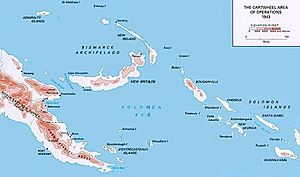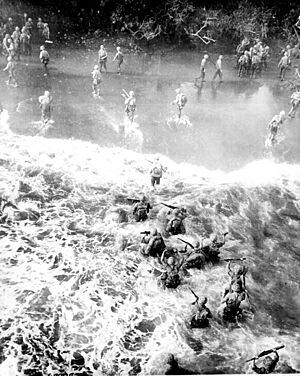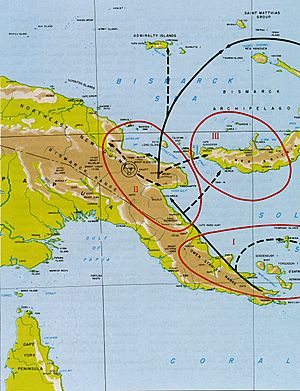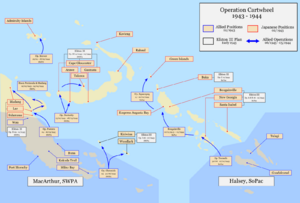Operation Cartwheel facts for kids
Operation Cartwheel was a huge military plan for the Allies during World War II in the Pacific. It took place from 1943 to 1944. The main goal of this operation was to make the big Japanese base at Rabaul harmless.
General Douglas MacArthur led the Allied forces in the Southwest Pacific. His troops moved along the coast of New Guinea and took over nearby islands. Meanwhile, Admiral William Halsey Jr. led Allied forces from the South Pacific. They advanced through the Solomon Islands towards Bougainville Island. Soldiers from Australia, the Netherlands, New Zealand, the United States, and various Pacific Islands all took part in Operation Cartwheel.
Contents
Why Operation Cartwheel Was Needed
Japanese forces had captured Rabaul on New Britain in February 1942. They turned it into their main base in the South Pacific. This made Rabaul a big problem for the Allies.
General MacArthur came up with a plan called the Elkton Plan. This plan aimed to capture Rabaul. Other military leaders also had ideas. Eventually, they agreed on a plan with three main steps:
- First, capture Tulagi (which later became Guadalcanal) and the Santa Cruz Islands. This was called Operation Watchtower.
- Second, take control of the northeastern coast of New Guinea and the central Solomon Islands.
- Third, weaken Rabaul and other nearby Japanese bases.
The long battle for Guadalcanal was very tough. After that, the Allies took the Russell Islands without a fight in February 1943. The Japanese tried to send more supplies and soldiers by sea. But MacArthur's air forces stopped them in the Battle of the Bismarck Sea in March 1943. The Japanese lost many ships and planes. This led to Admiral Isoroku Yamamoto launching air attacks called Operation I-Go. Sadly for the Japanese, this operation eventually led to his death in April 1943.
How Operation Cartwheel Was Carried Out
In February 1943, General MacArthur presented his updated plan, Elkton III. This plan aimed to take Rabaul before 1944. It involved MacArthur's forces attacking northeastern New Guinea and western New Britain. At the same time, Admiral William F. Halsey Jr.'s forces would attack the central Solomon Islands.
The plan needed more soldiers than were available. This caused some disagreements. But eventually, the plan was approved using the forces already there or on their way. The start of the operation was delayed by 60 days. This revised plan then became known as Operation Cartwheel.
Key Operations
Operation Cartwheel included many smaller operations. Some targets, like Rabaul and Kavieng, were later skipped. This was because they would have been too costly to capture. Instead, the Allies decided to make them harmless by cutting off their supplies. Only 11 of the planned operations were actually carried out. For example, the Green Islands, which were close to Rabaul, were taken instead of Kavieng.
Here are some of the important operations that were part of Cartwheel:
- Operation Chronicle – Started June 30, 1943.
- Woodlark Island
- Kiriwina
- Operation Toenails – Started June 30, 1943.
- New Georgia
- Segi Point, New Georgia
- Rendova
- Zanana, New Georgia
- Bairoko, New Georgia
- Arundel Island
- Vella Lavella – Started August 15, 1943.
- Operation Postern – Started September 5, 1943.
- Lae, New Guinea
- Operation Goodtime – Started October 27, 1943.
- Treasury Islands
- Operation Blissful – Started October 28, 1943.
- Operation Cherryblossom – Started November 1, 1943.
- Bougainville Island
- Operation Dexterity
- Arawe, New Britain – Started December 15, 1943.
- Cape Gloucester – Started December 26, 1943.
- Saidor – Started January 2, 1944.
- Green Islands – Started February 15, 1944.
- Admiralty Islands – Started February 29, 1944.
- Emirau Island – Started March 20, 1944.
Australian forces, led by General Thomas Blamey, were in charge of moving eastward on mainland New Guinea. The US 6th Army, led by General Walter Krueger, was to take Kiriwina, Woodlark, and Cape Gloucester. Air support came from Allied air units under Lieutenant General George Kenney. Naval support came from Vice Admiral Arthur S. Carpender.
During Operation Cartwheel, leaders decided to bypass Rabaul. This meant they would isolate it instead of trying to capture it directly. They also decided to bypass Kavieng. This strategy of avoiding strong enemy forces and cutting off their supplies proved to be very effective.
Making Rabaul Harmless
In December 1943, the Japanese Navy tried to save Rabaul. They sent hundreds of airplanes from their aircraft carriers at Truk. But this only led to the destruction of many of their own valuable planes. They also lost many experienced pilots. This big loss of Japanese aircraft helped the US Navy prepare for the Marianas campaign a few months later. Also, the Admiralty Islands campaign began in late February 1944 after the Allies confirmed that Rabaul no longer had any airplanes.
By February 1944, Rabaul had no more fighter or bomber planes left for the rest of the war. This was because of the constant bombing by Allied planes based only a few hundred miles away. On February 19, 120 Japanese planes were moved to Truk. Japanese mechanics tried to leave Rabaul by ship on February 21. But their ship, the Kokai Maru, was sunk by Allied bombers. Rabaul became a dangerous place for the Japanese. They refused to surrender, even as their food and medicine ran out.
See also
- Structure of the Imperial Japanese forces in the South Seas Mandate, details on Japanese forces in bypassed islands





